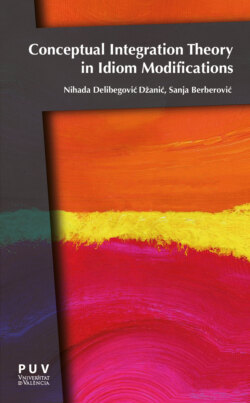Читать книгу Conceptual Integration Theory in Idiom Modifications - Nihada Delibegović Džanić - Страница 8
На сайте Литреса книга снята с продажи.
Оглавление1
Introduction
In this book we will try to throw more light on mechanisms of idiom modification. Previous studies of idiom modification have not suggested a consistent argument why only certain types of modifications are acceptable for a given idiom whilst others are not. Actually, previous studies have not provided a coherent answer to the question to what extent an idiom can be modified to retain the link with the original phraseological unit, so that recipients can recognize it as a modification of an established original. The main aim of this study is to analyse the extent to which vital relations and optimality principles at work in conceptual integration can account for mechanisms of idiom modification. We also aim to present an overview and analysis of previous studies of idioms and idiom modifications and give an overview and analysis of cognitive linguistic theories that can account for the mechanisms of idiom modifications.
Our main hypothesis is idiomatic expressions are variable, and their variations can be explained using the postulates of the Conceptual Integration Theory. Mechanisms of idiom modification have semantic, syntactic and pragmatic constraints. Constraints of modification mechanisms can be explained using vital relations and optimality principles that define relations within conceptual integration networks.
The theoretical framework for this study is the Conceptual Integration Theory, proposed by Fauconnier and Turner (1998, 2002), which aims to account for both linguistic and non-linguistic blends. Creating an integration network is the basis of this theory. Conceptual integration network consists of minimum two input spaces, one generic space and one blended space. Establishing mental spaces, connections between them and blended spaces gives us global insight, new meaning and human-scale understanding. Optimality principles, proposed by Fauconnier and Turner, clarify the relations within the conceptual integration network. These optimality principles are: integration, web, unpacking, topology, good reason, and metonymic tightening. According to Fauconnier and Turner (2002), relations within the conceptual integration network are also regulated with a set of vital relations. They distinguish the following vital relations: change, identity, time, space, cause-effect, part–whole, representation, role, analogy, disanalogy, property, similarity, category, intentionality and uniqueness.
The method used in this study is corpus analysis. Vital relations and optimality principles are tested on selected modified linguistic expressions from the corpus to explain the mechanisms of idiom modification.
The corpus comprises selected examples of idiom modifications collected from magazines Time, The New Yorker, The Economist, National Geographic, Cosmopolitan, Marie Claire. 20 examples were collected from general reading and the electronic media. 15 examples were also taken from the British National Corpus. The reason for including such a limited number of idiom modifications from the BNC lies in the fact that some registers rich in idiom modifications are poorly represented in the BNC.1
1 Cf. Omazić (2003).
